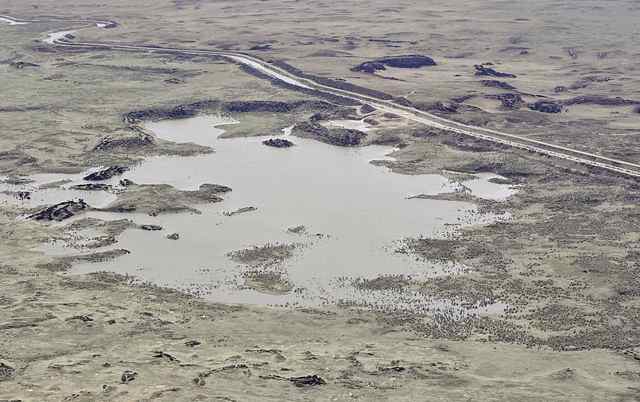forum
library
tutorial
contact

State Falls Short of Recharge Goal,
But Develops New Infrastructure
by John O'Connell
Capital Press, April 13, 2016
|
the film forum library tutorial contact |

|
State Falls Short of Recharge Goal,
by John O'Connell
|
 RIRIE, Idaho -- An Idaho Department of Water Resources official said the state failed to meet last winter's volume in its recently concluded Snake River managed aquifer recharge program, and fell well short of its projected goal.
RIRIE, Idaho -- An Idaho Department of Water Resources official said the state failed to meet last winter's volume in its recently concluded Snake River managed aquifer recharge program, and fell well short of its projected goal.
Recharge entails intentionally allowing surface water to seep into the aquifer to bolster declining levels, using irrigation canals and a network of strategically selected spill basins.
IDWR recharge coordinator Wesley Hipke said the state hoped to recharge 80,000 acre-feet this year, and plans to build the annual program up to 250,000 acre -feet by about 2020. Due to construction affecting levels in Milner Dam, however, Hipke said the state recharged 66,000 acre-feet this winter, about 8,000 acre-feet less than the prior year.
The state has a recharge right of 1,200 cubic feet per second that remains in priority throughout the winter below American Falls Reservoir. Hipke explained Milner water levels were dropped late in the winter to accommodate construction on an A&B Irrigation District pipeline, and inflows were needed to refill the pool after the project's completion.
Furthermore, Hipke said the state won't have an opportunity this season to conduct recharge in the Upper Snake Valley, where water from flood releases to free reservoir capacity is available for spring recharge in at least half of years. He said the state recharged 14,000 acre-feet in the Upper Valley last spring. The good news, Hipke said, is that the state has completed new infrastructure throughout the system to increase its future recharge capacity.
On April 12, Hipke attended a tour for Idaho Water Resource Board members of two major projects that were recently completed in the Upper Valley. The state contributed $500,000 toward a $1.4 million head gate replacement on the Great Feeder Canal in Ririe -- a project canal company board member Stan Hawkins said was two decades in the making.
"The old head gates were so leaky, there was no way to effectively measure or control the flows," Hawkins said, adding the leaky gates couldn't be shut off to address an icing problem when the system conducted recharge last spring. "We think an enhancement the gates give us is accountability as to how much water is actually put into the aquifer."
The new head gates also have more capacity to divert water for recharge.
The state paid the full $1.03 million to build a 2.25-mile canal on the Egin Bench of St. Anthony accessing a desert spill basin. The new canal will remain dry when it's not in use for recharge -- or taking managed-spill water to aid in the company's operations. The main canal will continue to serve customers and also provides 20 to 30 cubic feet per second of recharge capacity to Egin Lakes and the desert spill basin. The new, recharge canal adds an additional 125 cubic feet per second of recharge capacity, said Jeff Raybould, a Water Board member who farms at the site of the new canal.
Water Board Chairman Roger Chase explained the Egin site, located on the Henry's Fork, offers exceptional retention for recharge water, with half of the water injected remaining in the system after five years.
Hipke said Upper Valley flood releases are most common in May or June, and the state intends to develop additional off-canal recharge sites to facilitate recharge without disrupting irrigation deliveries.
learn more on topics covered in the film
see the video
read the script
learn the songs
discussion forum
